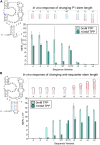A transient intermediate RNA structure underlies the regulatory function of the E. coli thiB TPP translational riboswitch
- PMID: 37419663
- PMCID: PMC10578472
- DOI: 10.1261/rna.079427.122
A transient intermediate RNA structure underlies the regulatory function of the E. coli thiB TPP translational riboswitch
Abstract
Riboswitches are cis-regulatory RNA elements that regulate gene expression in response to ligand binding through the coordinated action of a ligand-binding aptamer domain (AD) and a downstream expression platform (EP). Previous studies of transcriptional riboswitches have uncovered diverse examples that utilize structural intermediates that compete with the AD and EP folds to mediate the switching mechanism on the timescale of transcription. Here we investigate whether similar intermediates are important for riboswitches that control translation by studying the Escherichia coli thiB thiamin pyrophosphate (TPP) riboswitch. Using cellular gene expression assays, we first confirmed that the riboswitch acts at the level of translational regulation. Deletion mutagenesis showed the importance of the AD-EP linker sequence for riboswitch function. Sequence complementarity between the linker region and the AD P1 stem suggested the possibility of an intermediate nascent RNA structure called the antisequestering stem that could mediate the thiB switching mechanism. Experimentally informed secondary structure models of the thiB folding pathway generated from chemical probing of nascent thiB structures in stalled transcription elongation complexes confirmed the presence of the antisequestering stem, and showed it may form cotranscriptionally. Additional mutational analysis showed that mutations to the antisequestering stem break or bias thiB function according to whether the antisequestering stem or P1 is favored. This work provides an important example of intermediate structures that compete with AD and EP folds to implement riboswitch mechanisms.
Keywords: RNA folding; SHAPE-Seq; riboswitches; translation regulation.
© 2023 Berman et al.; Published by Cold Spring Harbor Laboratory Press for the RNA Society.
Figures





Similar articles
-
Insights into the cotranscriptional and translational control mechanisms of the Escherichia coli tbpA thiamin pyrophosphate riboswitch.Commun Biol. 2024 Oct 17;7(1):1345. doi: 10.1038/s42003-024-07008-5. Commun Biol. 2024. PMID: 39420148 Free PMC article.
-
Structural Characterization of the Cotranscriptional Folding of the Thiamin Pyrophosphate Sensing thiC Riboswitch in Escherichia coli.Biochemistry. 2024 Jul 2;63(13):1608-1620. doi: 10.1021/acs.biochem.3c00665. Epub 2024 Jun 12. Biochemistry. 2024. PMID: 38864595
-
Cotranscriptional Folding of a 5' Stem-loop in the Escherichia coli tbpA Riboswitch at Single-nucleotide Resolution.J Mol Biol. 2024 Nov 15;436(22):168771. doi: 10.1016/j.jmb.2024.168771. Epub 2024 Aug 30. J Mol Biol. 2024. PMID: 39218381
-
Exploring the structure, function of thiamine pyrophosphate riboswitch, and designing small molecules for antibacterial activity.Wiley Interdiscip Rev RNA. 2023 Jul-Aug;14(4):e1774. doi: 10.1002/wrna.1774. Epub 2023 Jan 2. Wiley Interdiscip Rev RNA. 2023. PMID: 36594112 Review.
-
Linking aptamer-ligand binding and expression platform folding in riboswitches: prospects for mechanistic modeling and design.Wiley Interdiscip Rev RNA. 2015 Nov-Dec;6(6):631-50. doi: 10.1002/wrna.1300. Epub 2015 Sep 11. Wiley Interdiscip Rev RNA. 2015. PMID: 26361734 Free PMC article. Review.
Cited by
-
Sequential structure probing of cotranscriptional RNA folding intermediates.bioRxiv [Preprint]. 2024 Oct 17:2024.10.14.618260. doi: 10.1101/2024.10.14.618260. bioRxiv. 2024. Update in: Nat Commun. 2025 Jun 1;16(1):5085. doi: 10.1038/s41467-025-60425-w. PMID: 39464030 Free PMC article. Updated. Preprint.
-
Kinetic pathway of HIV-1 TAR cotranscriptional folding.Nucleic Acids Res. 2024 Jun 10;52(10):6066-6078. doi: 10.1093/nar/gkae362. Nucleic Acids Res. 2024. PMID: 38738640 Free PMC article.
-
Insights into the cotranscriptional and translational control mechanisms of the Escherichia coli tbpA thiamin pyrophosphate riboswitch.Commun Biol. 2024 Oct 17;7(1):1345. doi: 10.1038/s42003-024-07008-5. Commun Biol. 2024. PMID: 39420148 Free PMC article.
-
The role of structure in regulatory RNA elements.Biosci Rep. 2024 Oct 30;44(10):BSR20240139. doi: 10.1042/BSR20240139. Biosci Rep. 2024. PMID: 39364891 Free PMC article. Review.
-
Opportunities for Riboswitch Inhibition by Targeting Co-Transcriptional RNA Folding Events.Int J Mol Sci. 2024 Sep 29;25(19):10495. doi: 10.3390/ijms251910495. Int J Mol Sci. 2024. PMID: 39408823 Free PMC article. Review.
References
Publication types
MeSH terms
Substances
Grants and funding
LinkOut - more resources
Full Text Sources
Molecular Biology Databases
Research Materials
